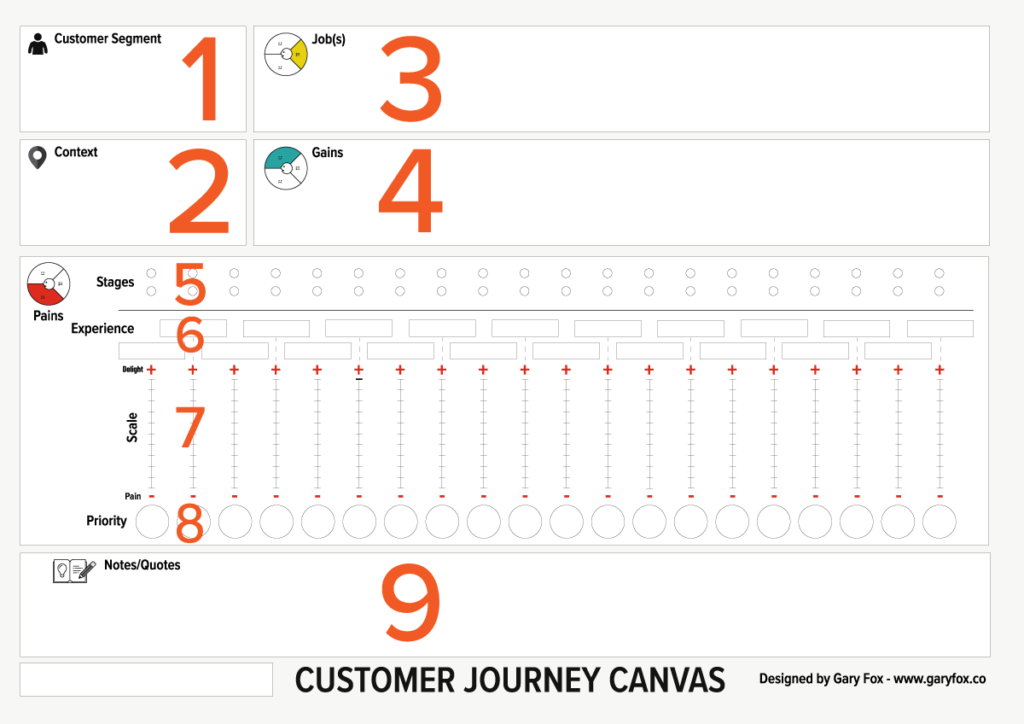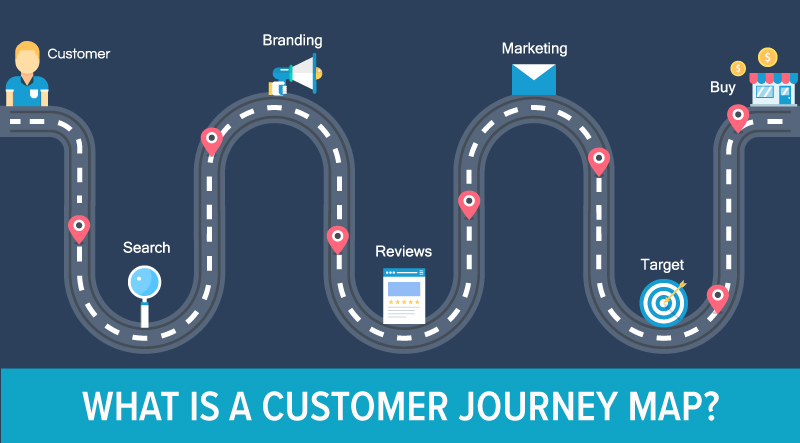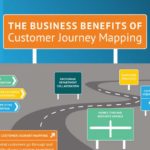I often get asked to explain what is a customer journey map? Marketing and design teams alike understand the fundamentals of what is a customer journey map. However, they often need a deeper understanding of the principles and science behind customer mapping.
Table of Contents
How to define the stages of the customer journey map
Many people use marketing funnel as a way to mark the different stages. However, it is often better to consider the different jobs and decisions a customer makes during the customer journey. You can find common stages and clear points that can be grouped together.
The rows show various processes and people interacting with the customer. The final lower section shows the outcomes and insights. There is no one size fits all customer journey map. Typically I will start with a template which then gets customised according to the specific project.
Understanding the common elements of the customer journey map opens up the possibilities for how to adapt and use it. The core principle of the customer journey map is that it aligns the interactions between the organisation and the customer.
Break Down of What Is a Customer Journey Map

Section 1: This provides the lens provides constraints for the map by assigning (1) a persona (“who”) and (2) the scenario to be examined (“context – e.g. where and when”).
Section 5,6,7 and 8: The center of the map is the customer experience, usually aligned across phases of the journey. The actions, thoughts, and emotional experience of the customer across the touchpoints.
Section 9: The exact words expressed by the customer will depend on the business goal. Typically, it will describe the insights and pain points discovered, and the opportunities to focus on going forward, as well as (8) internal ownership.
The Benefits of a Customer Journey Map
The customer journey map is a compelling way for organisations to develop a competitive advantage. The customer experience (CX) has become a key differentiator for today’s top brands, with companies in all industries rushing forward to advance their CX programs. For maximum CX results, companies need to have a sense of the future of the customer experience to best allocate precious time and resources.
A customer journey map is a visualization tool to help build a big picture that cuts across silos of activities within an organisation. When I use them with cross-departmental teams they build a deeper understanding and focus on achieving business goals.
The customer journey map forms a way of looking from the outside-in that changes the perspective of team members. The customer journey mapping process helps break down the typical silos that inhibit collaboration and create a shared vision of the organisation.
Rather than looking at spreadsheets, the customer journey map is easy to understand and quickly reveals opportunities for improving and innovating. They bring a sharp focus to what and how aspects of the organisation can improve the customer experience.
Brand integrity is the sum of the parts from brand promise to brand delivery. A customer journey map can reveal how the brand is experienced and therefore the degree of brand integrity, in other words, whether the brand is being compromised by incoherent touchpoints, poor service delivery…
I often find that they form a benchmark, a base point, from which organisations can then test to see how well they have improved the customer experience.
What are the elements of the customer journey map?
Customer journey maps vary according to the goals, objectives and situation being considered. Although often overlooked, the customer journey map can also be used for internal ‘customer’ experiences. As an example, I have used the customer journey map to map the recruitment and induction of new employees.
The customer journey map is a distillation of your research, not all of your research. As an example, there may be many touchpoints that are omitted in the final version. Whilst all touchpoints need to be designed, you have to focus on the goal. The goal is to focus on the parts of the customer experience where the organisation can provide a relevant and coherent experience to the customer.
1. Point of View
The point of view determines who is the customer journey map about. This is normally based on a customer persona. Once you have decided on the people to focus on then you are ready to either start your research or use your existing data.
2. Scenario
This is the experience that is the focus of the customer journey map. This could be an existing journey, where mapping will uncover positive and negative moments within that current experience or future experience design. Often the map can form the vision for customer experience based on a new product or service. Typically for organisations, the experience being mapped is related to purchase behaviour, customer service, retail operations or a day in the life.
3. Scope
The scope requires a clear definition of what is to be delivered, how and the level of detail required to achieve the goal. Often this requires defining the start and endpoint of the customer experience.
4. Actions and perspectives –
The customer journey map is a tool to tell a story. The data points then are the narrative. The data collected needs to reflect the doing, thinking, feeling, challenges, context and behaviours…in a sequence of experiences. These experiences can be the events, devices, communications and processes that form the touchpoints. From the organisation, these need to be related to the organisational strategy, goals, operations and metrics. Tying these together then delivers the opportunities.
5. Structure
Simplicity is at the heart of good design without forfeiting the delivery of the insights. The structure of the customer journey map needs to reflect on how it will be used and by who. Will it be used to develop a strategy or to diagnose problems?
6. Touchpoints and channels
The map should align touchpoints (points when the customer in the map interacts with the organisation) and channels (methods of communication or service delivery, such as the website or physical store) with user goals and actions. The inconsistencies, disconnected communications and poor services then form the basis for the insights and actions.
Typical touchpoints include:
- Marketing emails, newsletters
- Phone calls, service and support lines, online chatbots
- Store staff, checkout register, service points
- Website, apps, social media
- Physical objects, buildings, roads, offices
- Packaging, shipping, delivery
- Bills, invoices, payment systems
7. Moments of truth
These are the touchpoints that are critical that go on to define the overall customer experience, either negatively or positively. Moments of truth are opportunities to innovate and grow because they represent moments (e.g. pain points) that people are willing to pay to address their critical needs. The idea underpinning the customer map is to recognise how an organisation can deliver value.
Rules for Creating Customer Journey Maps
The critical concept for the customer journey mapping process is to capture the experiences of people. To achieve this requires the framing of the map: making decisions about the scope, perspective, focus and structure.
Successful journey maps require a collaborative process informed by well-defined goals and built from research. It requires understanding the motivations for creating the map and the goals of the stakeholders.
Establish the “why and the “what”. First, identify the business goal that the journey map will support. There needs to be clear answers to these basic key questions before you begin the process:
- What business goal does this journey map support?
- Who will use it?
- Who is it about and what experience does it address?
- Who will participate in the development?
- Who will be responsible for implementing the results?
Underpinned by research. Journey maps need to be underpinned by solid research. The quality, age and relevance of existing research needs to be examined, but additional journey-based research will be needed. This is a qualitative-research process but can be supplemented with quantitative data. Quantitative data will validate (or aid in convincing stakeholders who may view qualitative data as “fuzzy”).
Collaborate with others. The activity of journey mapping (not the output itself) is often the most valuable part of the process. It is always amazing how the process itself helps to unite cross-functional teams. The team involved needs to be chosen from relevant cross-functional groups. Together they can compile the data and build the map.
Don’t jump to visualization. The temptation to create a graphic or jump to design can lead to beautiful yet flawed journey maps. Make sure the synthesis of your data is complete and well-understood before moving to create the visual.
Engage others with the end product. Don’t expect to get “buy-in” and foster interest in your journey map by simply sending a lovely graphic as an email attachment. Make it a living interactive document that people can be a part of. Bring up your story in meetings and conversations to promote a narrative that others believe in and begin to reference. One idea is to create a journey-mapping showroom where anyone not on the direct team can come experience the process and resulting artefacts.
Download the Customer Journey Canvas.


